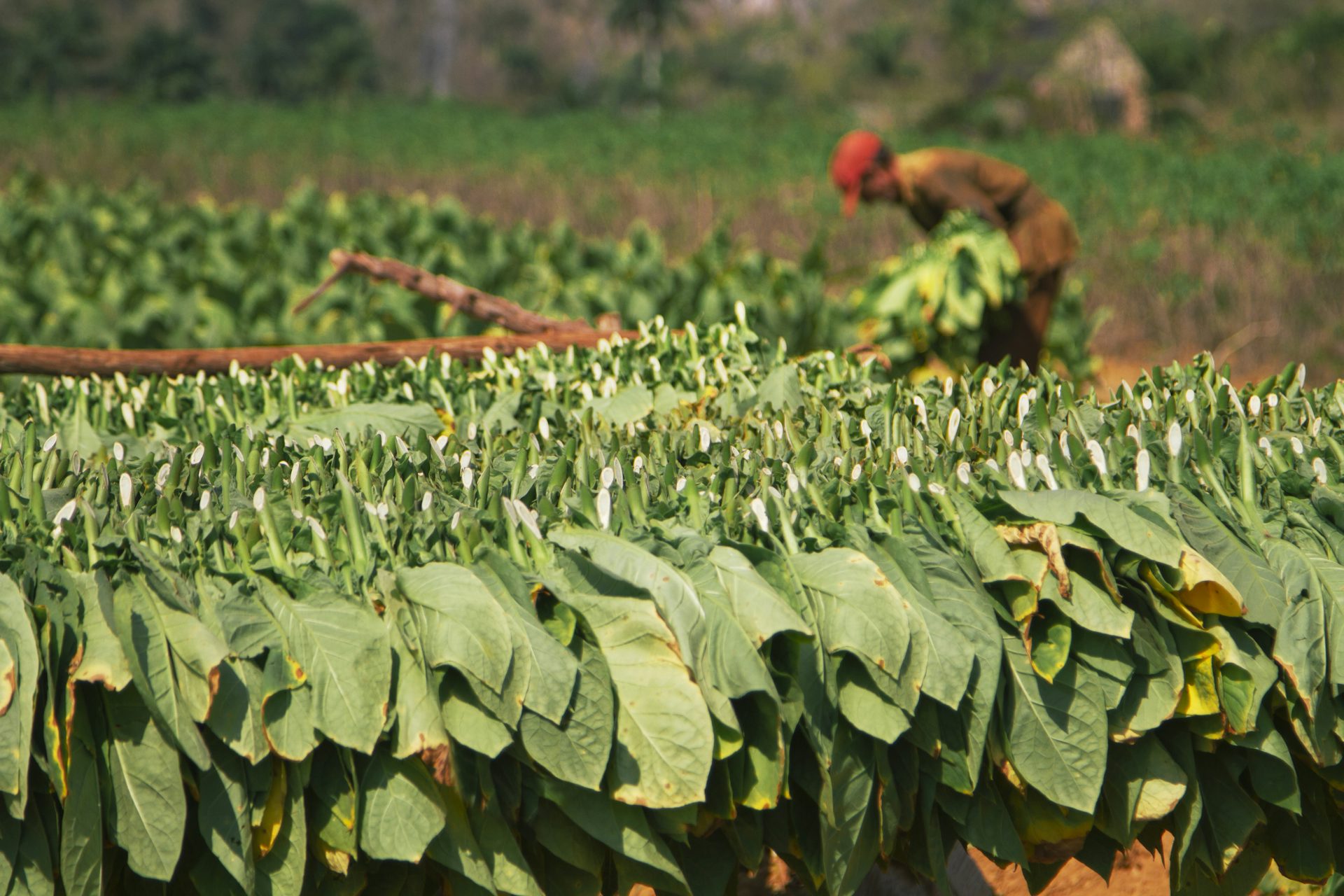The environmental impact of vape products: Pollution from production to “disposal”

Step 1: Pollution starts at the source – production
Starting at the very beginning of their production, vapes are devastating for our environment. Sourcing raw materials for these products is highly resource intensive, requiring not just plastics, but heavy metals, lithium-ion for batteries, and nicotine from tobacco plants.12
Take the lithium batteries in vapes, for example. Lithium mining for these types of batteries creates an environmental issue of rising concern. In one form of mining, around 15 metric tons of carbon dioxide (CO2) are emitted for every ton of lithium sourced.3 This extraction process also requires the use of chemicals and immense amounts of water and can leave contaminants and other toxic waste in its wake.4
The nicotine used in these products often comes from tobacco plants.5 With the farming of tobacco plants comes the destruction of forests, contamination of soil, and depletion of water supplies that is common practice across the tobacco product production chain.6 Not only does tobacco require the use of harsh pesticides and fertilizers which damage the soil, but the industry cuts down nearly 600 million trees a year for growing, harvesting, and curing.78 To put that into perspective, that’s over 16 times the amount of trees California lost this past year primarily to drought.9

From soil to store, tobacco farming is destroying our health and our planet.
Step 2: The tobacco industry’s environmentally problematic sales model
By design, the majority of vapes are meant to be disposed of after single or short-term use, which is why some vape products feature replaceable pods or cartridges pre-filled with e-juice.10 This sales model ensures that consumers constantly need to purchase new products, which creates new waste. At the beginning of 2020, rising vape use among youth prompted action from the Food and Drug Administration (FDA): The agency banned flavors other than tobacco and menthol in pod or cartridge-based vapes.11 But thanks to intense tobacco industry lobbying efforts, the FDA’s policy did not include disposable vapes.1213 Not surprisingly, the popularity of disposable products like Puff Bar took off.14 Even as the FDA tried to remove these products, other disposable vapes flooded the marketplace and today, disposable vapes remain one of the most popular flavored tobacco products among youth.151617
Vape waste isn’t new. The environmental impacts of vape products are visible throughout the state, including on school campuses. In 2019, California researchers did some “shoe-leather investigating,” collecting tobacco, cannabis, and vape waste from a dozen high school parking lots across the San Francisco Bay Area. Vape waste made up 19 percent of the litter recovered – debris that would have been hard to find on school campuses, let alone in the environment, a decade ago.18
By nature, the environmental impact of vaping produces extremely high volumes of waste. Consider that one survey found that 3.6 million U.S. adults vape daily.19 If even just one-third of this group uses one pod or disposable vape a day, that would produce nearly half a billion pieces of vape waste in one year. And this isn’t counting vape waste from the estimated more than 2.5 million U.S. middle and high school students who vape.20
To make matters worse, disposable vapes create a huge plastic pollution problem. Almost every part of a vape is made of plastic.21 Whether it’s the device body, pods or cartridges, or the battery housing, these components never biodegrade.22
Meaning that while vapes almost never completely deteriorate, they break down into smaller and smaller pieces of plastic called microplastics.23 Though often invisible to the human eye, microplastics are a global problem – polluting the food we eat, the water we drink, and even the air we breathe.242526 Microplastics have been found in sea water, tap water, and urban water runoff.272829 Due to their tiny size, microplastics are challenging to remove from our food and water sources.30 It may come as a surprise that Americans ingest an estimated hundreds of thousands of microplastic particles a year.31 According to studies, microplastics have been found in human lungs, placenta, and blood; they’ve been linked to fertility issues, intestinal damage, and even mutations in DNA.323334353637383940
The tobacco industry has made vapes increasingly convenient by marketing disposable products as smokeless, affordable, sleek, and full of flavors to mask the harsh taste of chemicals used in tobacco products.4142 This is to addict the next generation of consumers for profit, with little regard for public health or the environmental impact of vaping.
As tobacco companies roll out their products, they have marketed them as part of a newfound industry “commitment” to a greener, healthier future, but that’s nothing short of false advertising.
Step 3: More misleading industry myths: vape disposal and decay
So here we are: Unwanted plastic. Used-up e-juice. Toxic chemicals. Dead batteries. Because there’s no industry standard for how to recycle these tobacco products, vapes are often discarded in the trash or recycling bins, leading to a combination of plastic, hazardous waste, and e-waste, that wreaks havoc on our environment now and for years to come.45 Big Tobacco avoids disclosing this in their marketing and offers little to no guidance on how to dispose of their products because, put simply, there is no safe way to do so without taking it apart.46
The electronic waste components of vapes, like lithium-ion batteries, heating elements, microcontroller chips, and chargers, add another layer of disposal danger and environmental harm.47 It shouldn’t come as a surprise that 2.7 million tons of consumer electronic waste, including vape waste, wound up in landfills or incinerators in the U.S. in 2019.48 If vapes are put into garbage or trash receptacles, they pose a fire risk in waste and recycling facilities if damaged or exposed to high heat, putting buildings and workers’ safety at risk.4950
Discarded vapes are not biodegradable and cannot be recycled easily. When thrown in the trash, they can release toxic chemicals.
Countering Big Tobacco’s lies
Big Tobacco does everything in its power to continue to deceive the public into thinking that vapes aren’t a huge strain on public health or a source of toxic tobacco pollution.6263
The most meaningful step we can take towards holding Big Tobacco accountable for the devastating environmental impact of vape products is refusing to play their games.
So, where do we start?
If you currently vape, quit. Do it for your health and the environment! If you need help, Kick It California has free vape quitting services, including an app. Visit KickItCA.org for more information.
Even if you don’t use tobacco products, everyone can get involved in their community’s efforts in a couple of ways:
- Help spread the word about harmful vape waste.
- Write a letter of concern.
- Connect with a local group that’s fighting back against the tobacco industry.
- Hendlin YH. Alert: Public Health Implications of Electronic Cigarette Waste. Am J Public Health. 2018;108(11):1489-1490. doi:10.2105/AJPH.2018.304699
- Lerner CA, Sundar IK, Watson RM, et al. Environmental health hazards of e-cigarettes and their components: Oxidants and copper in e-cigarette aerosols. Environ Pollut. 2015;198:100-107. doi:10.1016/j.envpol.2014.12.033
- How much CO2 is emitted by manufacturing batteries? (n.d.). MIT Climate Portal. Retrieved April 5, 2023, from https://climate.mit.edu/ask-mit/how-much-co2-emitted-manufacturing-batteries
- How much CO2 is emitted by manufacturing batteries? (n.d.). MIT Climate Portal. Retrieved April 5, 2023, from https://climate.mit.edu/ask-mit/how-much-co2-emitted-manufacturing-batteries
- Center for Tobacco Products. Nicotine is why tobacco products are addictive. U.S. Food and Drug Administration. Accessed April 18, 2023. https://www.fda.gov/tobacco-products/health-effects-tobacco-use/nicotine-why-tobacco-products-are-addictive
- Zafeiridou M, Hopkinson NS, Voulvoulis N. Cigarette smoking: An assessment of tobacco’s global environmental footprint across its entire supply chain. Environ Sci Technol. 2018;52(15):8087-8094. doi:10.1021/acs.est.8b01533
- Truth Initiative. Tobacco and the Environment.; 2021.
- Lecours N, Almeida GEG, Abdallah JM, Novotny TE. Environmental health impacts of tobacco farming: a review of the literature. Tob Control. 2012;21(2):191-196. doi:10.1136/tobaccocontrol-2011-050318
- Aerial Detection Survey: 2022 Summary Report. U.S. Department of Agriculture Forest Service; 2023. Accessed May 9, 2023.
- Chang H. Research gaps related to the environmental impacts of electronic cigarettes. Tob Control. 2014;23(suppl 2):ii54-ii58. doi:https://doi.org/10.1136/tobaccocontrol-2013-051480
- FDA finalizes enforcement policy on unauthorized flavored cartridge-based e-cigarettes that appeal to children, including fruit and mint. News release. U.S. Food and Drug Administration. January 2, 2020. Accessed May 4, 2023. https://www.fda.gov/news-events/press-announcements/fda-finalizes-enforcement-policy-unauthorized-flavored-cartridge-based-e-cigarettes-appeal-children
- Karlis N. The e-cig industry poured money into lobbying prior to Trump’s reversal on vaping ban. Salon.com. Published November 18, 2019. Accessed April 18, 2023. https://www.salon.com/2019/11/18/the-e-cig-industry-poured-money-into-lobbying-prior-to-trumps-reversal-on-vaping-ban/
- Karni A, Haberman M, Kaplan S. Trump retreats from flavor ban for E-cigarettes. The New York Times. https://www.nytimes.com/2019/11/17/health/trump-vaping-ban.html. Published November 18, 2019. Accessed April 18, 2023.
- Rosenthal H, Chow N, Mehta S, Pham D, Milanaik R. Puff bars: a dangerous trend in adolescent disposable e-cigarette use. Curr Opin Pediatr. 2022 Jun 1;34(3):288-294. doi: 10.1097/MOP.0000000000001123.
- FDA Notifies Companies, Including Puff Bar, to Remove Flavored Disposable E-Cigarettes and Youth-Appealing E-Liquids from Market for Not Having Required Authorization. U.S. Food and Drug Administration. July 20, 2020. Accessed May 4, 2023.
- https://www.foxbusiness.com/lifestyle/fda-warning-letters-e-cigarette-vape
- Park-Lee E, Ren C, Cooper M, Cornelius M, Jamal A, Cullen KA. Tobacco Product Use Among Middle and High School Students — United States, 2022. MMWR Morb Mortal Wkly Rep 2022;71:1429–1435. DOI: http://dx.doi.org/10.15585/mmwr.mm7145a1
- Wolfe E. Study raises concern about e-cigarette waste. Salon.com. Published October 27, 2019. Accessed May 9, 2023.
- Mirbolouk M, Charkhchi P, Kianoush S, et al. Prevalence and Distribution of E-Cigarette Use Among U.S. Adults: Behavioral Risk Factor Surveillance System, 2016. Ann Intern Med. 2018;169(7):429-438. doi:10.7326/M17-3440
- Cooper M, Park-Lee E, Ren C, Cornelius M, Jamal A, Cullen KA. Notes from the field: e-cigarette use among middle and high school students — United States, 2022. MMWR Morb Mortal Wkly Rep. 2022;71(40):1283-1285.
- California Youth Advocacy Network. The Burden of Tobacco on the Environment.; 2021.
- Our planet is choking on plastic. United Nations Environment Programme. Accessed May 4, 2023.
- A toxic, plastic problem: E-cigarette waste and the environment. Truth Initiative. https://truthinitiative.org/research-resources/harmful-effects-tobacco/toxic-plastic-problem-e-cigarette-waste-and-environment. Accessed April 18, 2023.
- Conti GO, Ferrante M, Banni M, et al. Micro- and nano-plastics in edible fruit and vegetables: the first diet risks assessment for the general population. Environ Res. 2020;187:109677. doi:10.1016/j.envres.2020.109677
- Zarus GM, Muianga C, Hunter CM, Pappas RS. A review of data for quantifying human exposures to micro and nanoplastics and potential health risks. Sci Total Environ. 2021;756:144010. doi:10.1016/j.scitotenv.2020.144010
- Prata JC. Airborne microplastics: consequences to human health? Environ Pollut. 2018;234:115-126. doi:10.1016/j.envpol.2017.11.043
- Choy CA, Robison BH, Gagne TO, et al. The vertical distribution and biological transport of marine microplastics across the epipelagic and mesopelagic water column. Sci Rep. 2019;9:7843. doi:10.1038/s41598-019-44117-2
- Moran K, Miller E, Mendez M, et al. A Synthesis of Microplastic Sources and Pathways to Urban Runoff. SFEI Technical Report: SFEI Contribution # 1049. Richmond, CA: San Francisco Estuary Institute; 2021.
- Zarus GM, Muianga C, Hunter CM, Pappas RS. A review of data for quantifying human exposures to micro and nanoplastics and potential health risks. Sci Total Environ. 2021;756:144010. doi:10.1016/j.scitotenv.2020.144010
- Padervand M, Lichtfouse E, Robert D, Wang C. Removal of microplastics from the environment: a review. Environ Chem Lett. 2020;18:807-828. doi:10.1007/s10311-020-00983-1
- Mohamed Nor NH, Kooi M, Diepens NJ, Koelmans AA. Lifetime accumulation of microplastic in children and adults. Environ Sci Technol. 2021;55(8):5084-5096.
- Pauly JL, Stegmeier SJ, Allaart HA, et al. Inhaled cellulosic and plastic fibers found in human lung tissue. Cancer Epidemiol Biomarkers Prev. 1998;7(5):419-428.
- Jenner LC, Rotchell JM, Bennett RT, Cowen M, Tentzeris V, Sadofsky LR. Detection of microplastics in human lung tissue using μFTIR spectroscopy. Sci Total Environ. 2022;831:154907. doi:10.1016/j.scitotenv.2022.154907
- Ragusa A, Svelato A, Santacroce C, Pet al. Plasticenta: first evidence of microplastics in human placenta. Environ Int. 2021;146:106274. doi:10.1016/j.envint.2020.106274
- Leslie HA, van Velzen MJM, Brandsma SH, Vethaak D, Garcia-Vallejo JJ, Lamoree MH. Discovery and quantification of plastic particle pollution in human blood. Environ Int. 2022;163:107199. doi:10.1016/j.envint.2022.107199
- Xie X, Deng T, Duan J, Xie J, Yuan J, Chen M. Exposure to polystyrene microplastics causes reproductive toxicity through oxidative stress and activation of the p38 MAPK signaling pathway. Ecotoxicol Environ Saf. 2020;190:110133. doi:10.1016/j.ecoenv.2019.110133
- Hou J, Lei Z, Cui L, et al. Polystyrene microplastics lead to pyroptosis and apoptosis of ovarian granulosa cells via NLRP3/Caspase-1 signaling pathway in rats. Ecotoxicol Environ Saf. 2021;212:112012.
- Hwang J, Choi D, Han S, Jung SY, Choi J, Hong J. Potential toxicity of polystyrene microplastic particles. Sci Rep. 2020;10(1):7391. doi:10.1038/s41598-020-64464-9
- Rubio L, Barguilla I, Domenech J, Marcos R, Hernández A. Biological effects, including oxidative stress and genotoxic damage, of polystyrene nanoparticles in different human hematopoietic cell lines. J Hazard Mater. 2020;398:122900. doi:10.1016/j.jhazmat.2020.122900
- Hu X, Biswas A, Sharma A, Sarkodie H, Tran I, Pal I, De S. Mutational signatures associated with exposure to carcinogenic microplastic compounds bisphenol A and styrene oxide. NAR Cancer. 2021;3(1):zcab004. doi:10.1093/narcan/zcab004.
- Kirkham C. Juul disregarded early evidence it was hooking teens. Reuters. https://www.reuters.com/investigates/special-report/juul-ecigarette/. Published November 5, 2019. Accessed February 4, 2020
- Campaign for Tobacco-Free Kids. Flavored Tobacco Products Attract Kids. tobaccofreekids.org. https://www.tobaccofreekids.org/assets/factsheets/0383.pdf. Published September 1, 2021. Accessed October 4, 2021.
- Houghton F, Houghton S, O’ Doherty D, McInerney D, Duncan B. ‘Greenwashing’ tobacco products through ecological and social/equity labelling: a potential threat to tobacco control. Tob Prev Cessation. 2018;4:37. doi:10.18332/tpc/99674.
- Word Health Organization, & STOP. (2022). Talking Trash: Behind the Tobacco Industry’s “Green” Public Relations (p. 7). exposetobacco.org.
- https://truthinitiative.org/sites/default/files/media/files/2021/04/E-Cigarette-Waste-Report-FINAL-042821.pdf
- Hendlin YH. Alert: Public Health Implications of Electronic Cigarette Waste. Am J Public Health. 2018;108(11):1489-1490. doi:10.2105/AJPH.2018.304699.
- Hendlin YH. Alert: Public Health Implications of Electronic Cigarette Waste. Am J Public Health. 2018;108(11):1489-1490. doi:10.2105/AJPH.2018.304699
- Truth Initiative. (2020). TOBACCO AND THE ENVIRONMENT Tobacco use is not only a health issue — it is also an environmental issue.. Washington, D.C. Retrieved from https://truthinitiative.org/sites/default/files/media/files/2021/03/Truth_Environment%20FactSheet%20Update%202021_final_030821.pdf
- Forster M. What Happens When You Throw Away E-Cigarettes? Waste Management Magazine. https://wasteadvantagemag.com/what-happens-when-you-throw-away-e-cigarettes/. Published November 21, 2018. Accessed July 8, 2020.
- Office of Resource Conservation and Recovery. An analysis of lithium-ion battery fires in waste management and recycling. Epa.gov. Published July 2021. Accessed April 19, 2023.
- Environmental Protection Agency (1980). CFR §261.33 Discarded commercial chemical products, off-specification species, container residues, and spill residues thereof.
- Hendlin YH. Alert: Public health implications of electronic cigarette waste. Am. J. Public Health. 2018;108(11):1489-1490.
- International Programme on Chemical Safety, World Health Organization. Nicotine. inchem.org. March, 1991. Accessed April 18, 2023.
- Environmental Protection Agency. Nicotine; Product cancellation order. Federal Register. 2009;74:26695-26696.
- Mishra A, Chaturvedi P, Datta S, Sinukumar S, Joshi P, Garg A. Harmful effects of nicotine. Indian J Med Paediatr Oncol. 2015 Jan-Mar;36(1):24-31. doi: 10.4103/0971-5851.151771
- Marynak KL, Gammon DG, Rogers T, Coats EM, Singh T, King BA. Sales of Nicotine-Containing Electronic Cigarette Products: United States, 2015. Am. J. Public Health.2017; 107(5):702-705
- Ayesha Ahmed. A Review of Electronic Cigarettes and Liquid Nicotine Poisoning Exposure Cases in the United States. J Pharm Pharm Sci. 2022;25:354-368. doi: 10.18433/jpps33141.
- Antoniewicz L, Brynedal A, Hedman L, Lundbäck M, Bosson JA. Acute effects of electronic cigarette inhalation on the vasculature and the conducting airways. Cardiovasc Toxicol. 2019;19(5):441-450. doi:10.1007/s12012-019-09516-x
- Nicotine: Systemic agent. Cdc.gov. Published July 8, 2021. Accessed April 19, 2023.
- Hendlin YH. Alert: Public health implications of electronic cigarette waste. Am. J. Public Health. 2018;108(11):1489-1490.
- Novotny TE, Hardin SN, Hovda LR, Novotny DJ, McLean MK, Khan S. Tobacco and cigarette butt consumption in humans and animals. Tob Control. 2011;20 Suppl 1(Suppl_1):i17-i20. doi:10.1136/tc.2011.043489
- Dewhirst T. Co-optation of harm reduction by Big Tobacco. Tob Control. 2021;30(e1):e1-e3. doi:10.1136/TOBACCOCONTROL-2020-056059
- World Health Organization. Tobacco and Its Environmental Impact: An Overview. Geneva: World Health Organization; 2017. Accessed April 18, 2023.
Explore the tobacco industry's damage
